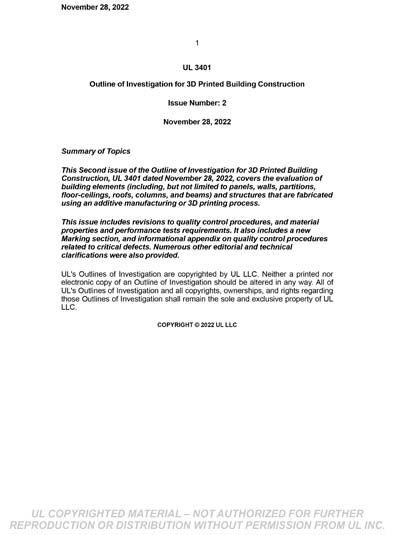Most recent
UL 3401 Ed. 2-2022
Outline of Investigation for 3D Printed Building Construction
1.1 This outline covers the evaluation of building elements (including, but not limited to panels, walls, partitions, floor-ceilings, roofs, columns, and beams) and structures that are fabricated using an additive manufacturing or 3D printing process. In this process a computerized model of the building element or structure is developed, then the model and slicing software are used to direct an automated 3D printer to extrude additive manufacturing materials in a layer upon layer deposition process, to form the building elements. 1.2 The evaluation process covered by this Outline is intended to produce technical information that can be used as a basis for determining if the building element or structure, as described in the fabricator’s Report of Findings, and constructed in accordance with an identified additive manufacturing process, complies with one or more identified building or residential codes, or government regulations covering the building construction, and applicable standards. 1.3 The reports produced as a result of the evaluation covered by these requirements serves three purposes: (1) to determine that the manufacturing process described in Sections 4 to 9 will consistently produce building elements or structures with equivalent properties to those demonstrated by the tests and evaluations conducted, and (2) to document ratings for tests conducted in accordance with standards referenced in the installation code(s), and (3) to document material properties and performance as described in the durability and integrity section of this Outline. These reports are intended to be used by the code official to determine compliance with the applicable installation code(s) using equivalency or alternate materials and methods provisions of the code. 1.4 This evaluation process can also be used to verify that system components of the structure that are fabricated during building construction using an additive manufacturing process comply with applicable requirements of product safety standards. This includes 3D printed outlet boxes, conduit, and electrical enclosures, among others. 1.5 The safety evaluation of the industrial 3D printers and ancillary equipment, are covered by the UL 2011, Outline of Investigation for Machinery. 1.6 Additive manufacturing facility safety management is covered by the UL 3400 Outline of Investigation for Additive Manufacturing Facility Safety Management. 1.7 These requirements do not evaluate the ability of the building element or structure to comply with installation code(s) structural design requirements. However the material property tests conducted on test samples produced using the fabrication process complying with Sections 4 – 9 can be used as a basis for structural loading calculations. 1.8 These requirements do not cover 3D printing of products not associated with a building or structure.
Underwriters Laboratories [ul]

